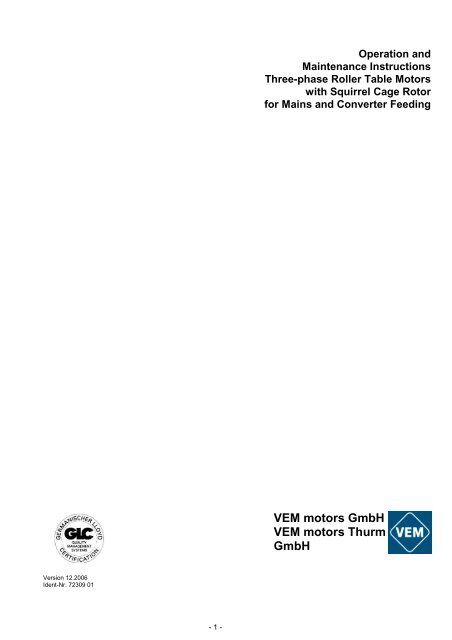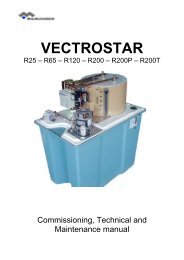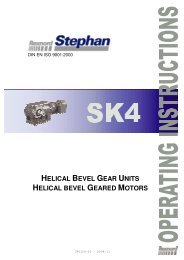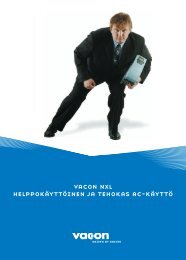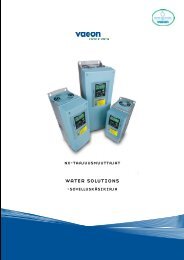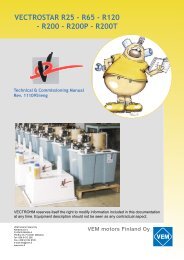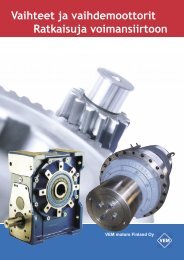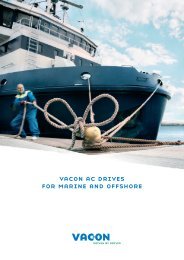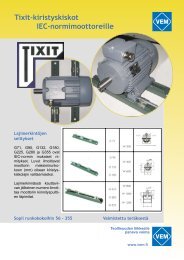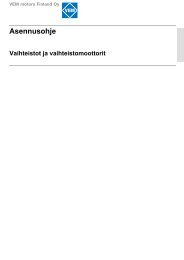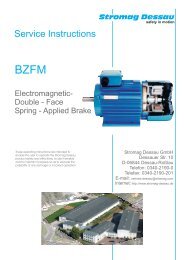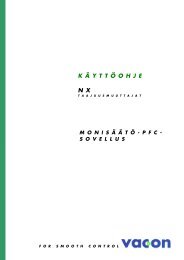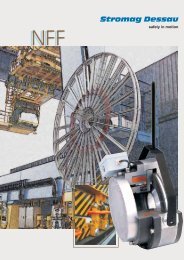Create successful ePaper yourself
Turn your PDF publications into a flip-book with our unique Google optimized e-Paper software.
Version 12.2006<br />
Ident-Nr. 72309 01<br />
- 1 -<br />
Operation and<br />
Maintenance Instructions<br />
Three-phase Roller Table Motors<br />
with Squirrel Cage Rotor<br />
for Mains and Converter Feeding<br />
<strong>VEM</strong> <strong>motors</strong> <strong>GmbH</strong><br />
<strong>VEM</strong> <strong>motors</strong> <strong>Thurm</strong><br />
<strong>GmbH</strong>
1. General<br />
To prevent damage to <strong>motors</strong> and the driven equipment the procedures laid down in the Operating and Maintenance Instructions<br />
must be followed. Especially to avoid risk of injury, the separately enclosed Safety Regulations must be adhered to<br />
strictly. Since for reasons of clarity the Operating and Maintenance Instructions cannot contain specific information with regard<br />
to all conceivable special applications and areas with special requirements, the user himself has to make appropriate protection<br />
arrangements during the installation process.<br />
Roller table <strong>motors</strong> are special driving elements for the rolling mill industry. Roller table <strong>motors</strong> are subjected to unusually hard<br />
electrical and mechanical requirements. This fact results from their extremely various modes of operation and load situations<br />
with their variants such as continuous duty, intermittent duty and short-time duty as well as starting duty, electrical braking duty<br />
and reversing duty. Roller table <strong>motors</strong> are able to handle operative overloads (e.g. blocking of the motor caused by jammed<br />
rolled material).<br />
1.1 Light roller table <strong>motors</strong>, type series A21R, A21O, A21F<br />
The type series A21R (IC 411), A21O (IC410), A21F (IC 416) are derived from the <strong>VEM</strong> standard motor series and are of the<br />
same mechanical design with regard to their main structural elements. The windings of these <strong>motors</strong> have been adapted for<br />
driving roller tables. Furthermore, all screwed connections are additionally secured, and the corrosion protection has also been<br />
adapted for use in rolling mills.<br />
1.2 Roller table <strong>motors</strong> for use with frequency converters, type series ARC<br />
The type series ARC (IC 410) has been developed for use with frequency converters in rolling mills.<br />
It provides a combination of the desirable properties of a converter-fed double squirrel cage rotor, with its acceleration-oriented<br />
torque characteristic (MC/MA approx. 3 ), and the mechanically robust design of a heavy roller table motor. With the exception of<br />
the form of its housing (ring-type ribs) and bearing/sealing arrangement on the drive end, its construction is identical to that of a<br />
<strong>VEM</strong> standard motor.<br />
1.3 Heavy roller table <strong>motors</strong>, type series ARB<br />
The heavy roller table motor ARB (IC 410) is intended for mains operation. Like the type series ARC the housing is provided<br />
with ring-type ribs and is composed of grey cast iron with ribs running transverse to the axis direction.<br />
2. Description<br />
The <strong>motors</strong> have been manufactured in accordance with IEC 34-1, DIN EN 60034-1, DIN VDE 0530 and other appropriate DIN<br />
standards. The details on the relevant Order Confirmation constitute the scope of supply.<br />
3. Degree of protection<br />
The degree of protection of the <strong>motors</strong> is indicated on their rating plate. The degree of protection of additional devices fitted to<br />
the motor can differ from the degree of protection of the motor. This needs to be taken into consideration during the installation<br />
of the <strong>motors</strong>. If <strong>motors</strong> are installed in the open (Protection Standard ≥ IP 44), they should be protected against direct effects<br />
of the climate (freezing of the fan due to direct fall of rain, snow and formation of ice).<br />
4. Type of construction<br />
The type of construction of the <strong>motors</strong> is indicated on the rating plate. The <strong>motors</strong> can be used in different types of construction<br />
only with the permission of the manufacturer and if necessary after modification carried out in accordance with the manufacturer’s<br />
instructions. Especially with types of construction with vertical shaft the user has to ensure that foreign particles cannot<br />
fall into the fan cowl.<br />
5. Transport & storage<br />
If possible the <strong>motors</strong> should only be stored in closed and dry rooms. Outdoor storage under cover is permitted for a short time<br />
only and requires adequate protection against all harmful effects of the climate. The <strong>motors</strong> also have to be protected against<br />
mechanical damage. Never transport or store <strong>motors</strong> resting on their fan cowls. The eye bolts of the <strong>motors</strong> together with appropriate<br />
lifting tackle must be used for transport. The eye bolts are intended for the lifting of the <strong>motors</strong> only, without any additional<br />
parts such as bed plates, gears etc. If eye bolts are removed after installation, the tapped holes must be blanked off<br />
permanently according to the degree of protection.<br />
6. Removal of the transport locking<br />
On <strong>motors</strong> with transport safety device (roller bearing), the hexagon head screw provided for the fastening of the transport<br />
safety device is to be loosened and taken off together with the transport safety device. Subsequently the bearing cover bolt<br />
packed in a bag inside the terminal box is to be screwed into the bearing cover. If it is necessary for the motor type the bag will<br />
also contain a lock washer that is to be placed onto the bearing cover bolt before screwing it into the bearing end shield.<br />
7. Installation and fitting<br />
Since during normal operation of electric <strong>motors</strong>, temperatures in excess of 100 °C can occur on their s urface, any contact with<br />
them must be prevented if the <strong>motors</strong> are installed in accessible areas. Because of this temperature sensitive parts must never<br />
be fitted to them or have contact with them. In types of construction IM B14 and IM B34 it must be ensured that the maximum<br />
usable screw depth specified in the catalogue is not exceeded, otherwise the winding will be damaged.<br />
Vent holes must be kept free and the minimum distances stated in the dimensional drawings must be maintained so that the<br />
flow of cooling air is not obstructed. Care must be taken that the discharged warmed up cooling medium is not sucked up<br />
again.<br />
The key in the shaft end is secured by the shaft protective sleeve for transport and storage only. Because of the danger that the<br />
key may be thrown aside, a start-up or a trial run with the key protected by the shaft sleeve only is strictly forbidden.<br />
Transmission elements (such as couplings, pinions or belt pulleys) should be drawn onto the shaft by means of pull-on devices<br />
or by heating-up the part to be drawn onto the shaft. For the purpose of drawing the transmission components onto the shaft,<br />
the shaft ends are provided with tapped centring holes according to DIN 332 Part 2. Transmission components must never be<br />
driven onto the shaft using hammer blows because the shaft, the bearings and other components of the motor could be damaged.<br />
All components that are to be fitted to the shaft end must be balanced dynamically according to the balancing system of<br />
the motor (full or half key). The rotors of the motor are balanced with half key; this is indicated by the letter H after the serial<br />
number on the rating plate. Motors with letter F after the serial number are balanced with full key. If possible the <strong>motors</strong> are to<br />
be installed in such a way that they are free from vibrations. With precision balanced <strong>motors</strong> special instructions are to be fol-<br />
- 2 -
lowed. When the installation is completed the user must ensure protection of movable parts and safety of operation.<br />
Direct coupling to the driven machine requires a particularly accurate alignment. The shafts of both machines must be in alignment.<br />
The shaft height is to be adjusted to that of the driven machine using appropriate shims. Belt drives put a lot of stress on<br />
the motor because of relatively high radial forces. When dimensioning belt drives, apart from the instructions and calculation<br />
programmes issued by the manufacturers of the belts, it must be ensured that the radial force permissible at the shaft end of<br />
the motor as stated in our data is never exceeded by the pull and pre-tensioning of the belt. When pre-tensioning the belt during<br />
installation the instructions of the belt manufacturers must be strictly adhered to.<br />
8. Insulation check<br />
When the motor is first commissioned and especially after extended storage, the insulation resistance of the winding is to be<br />
measured to earth and between phases. The check must take place using the rated voltage, but at least 500 V. During and<br />
immediately after the measurements dangerous voltages are present at the terminals. Therefore never touch the terminals and<br />
follow the operating instructions of the insulation resistance meter closely! Depending on the rated voltage UN, the following<br />
minimum values must be maintained with a winding temperature of 25 °C:<br />
Rated Power PN / kW Insulation Resistance referred to Rated Voltage / kΩ/V<br />
1 < PN ≤ 10 6.3<br />
10 < PN ≤ 100 4<br />
100 < PN<br />
2.5<br />
If the minimum values are lower, the winding must be dried properly until the insulation resistance corresponds to the required<br />
value.<br />
9. Commissioning<br />
Please follow the Safety Regulations closely.<br />
All work is to be carried out only when there is no voltage on the motor. The installation must be carried out according to the<br />
valid regulations by qualified skilled personnel.<br />
Initially the mains conditions (voltage and frequency) must be compared with the data on the rating plate of the motor. The<br />
dimensions of the connecting cables must be adjusted in line with the rated currents of the motor.<br />
The connection points of the motor are marked in accordance with DIN VDE 0530 Part 8. In Section 18 of these instructions the<br />
most common circuit diagrams for three phase <strong>motors</strong> in basic design are provided, according to which the connection will be<br />
implemented. For all other versions, the special circuit diagrams are glued to the inside of the terminal box cover or placed in<br />
the terminal box. An additional terminal box can be provided for the connection of auxiliary and protection devices (e.g. anticondensation<br />
heaters); the same regulations apply as for the main terminal box.<br />
Always start the <strong>motors</strong> with an over-current protection device that is set in accordance with the relevant nominal values of the<br />
motor (≈ 1.05 Inom). Otherwise warranty claims with respect to damaged windings become void. Before the motor is connected<br />
for the first time it is recommended to check the insulation resistances between winding and earth and between phases (see<br />
Section 8). After prolonged storage it is absolutely essential that the insulation resistance is measured. Before coupling the<br />
motor to the driven machine, check the direction of rotation of the motor to prevent possible damage being caused to the driven<br />
machine. If the mains supply with the phase sequence L1, L2 and L3 is to be wired to the connection points U, V, W, the motor<br />
is rotating clockwise looking at the shaft end. The direction of rotation can be changed by swapping the connections between 2<br />
phases. For the permissible tightening torques for the terminal board bolts refer to the table below:<br />
Terminal Board Connecting Bolt Thread Permissible Tightening Torque in Nm<br />
16 A M4 1.2 + 0.5<br />
25 A M5 2.5 ± 0.5<br />
63 A M6 4 ± 1<br />
100 A M8 7.5 ± 1.5<br />
200 A M10 12.5 ± 2.5<br />
400 A M12 20 ± 4<br />
630 A M16 30 ± 4<br />
Before closing the terminal box make absolutely sure that:<br />
- the connection has been made in accordance with the wiring diagram<br />
- all terminal box connections are tightened<br />
- all minimum values of air paths are maintained (larger than 8 mm up to 500 V, larger than 10 mm up to 750 V, larger than<br />
14 mm up to 1000 V)<br />
- the interior of the terminal box is clean and free from foreign particles<br />
- unused cable entries are blanked off and the threaded plugs with seals are tightened<br />
- the seal in the terminal box cover is clean and tightly glued and all sealing surfaces are in the correct state to ensure that the<br />
relevant degree of protection is maintained.<br />
Before starting up the motor check that all safety regulations are strictly adhered to, that the machine is correctly installed and<br />
aligned, that all fixing parts and earth connections are tightened, that the auxiliary and additional devices are functionally and<br />
correctly connected and if a second shaft end is fitted that the key is secured against being thrown aside.<br />
If possible the motor is to be connected without load. If the motor is running smoothly and without any abnormal noises, the<br />
load of the driven machine is to be applied onto the motor. When the motor is started up it is recommended to monitor the<br />
current consumption if the motor is loaded with its driven machine so that any possible overloads and asymmetries occurring in<br />
the mains can be recognised immediately.<br />
Please always observe the Safety Regulations during operation of the motor and when switching it off.<br />
10. Maintenance<br />
You are once again referred to the Safety Regulations, in particular to insulation, to securing against reconnection, to checking<br />
whether all components connected to a voltage source are in dead state.<br />
If it is necessary to disconnect the motor from the mains for maintenance work particular care must be taken to ensure that any<br />
possibly existing auxiliary circuits (e.g. anti-condensation heaters, forced ventilators, brakes) are also disconnected from the<br />
mains.<br />
- 3 -
If the motor is to be dismantled during maintenance work, the sealing compound on the centring shoulders is to be removed.<br />
When re-assembling the motor these need to be re-sealed using a suitable motor sealing compound. Existing copper sealing<br />
washer must always be refitted.<br />
11. Draining of condensation water<br />
On installation sites where formation of dew and thus occurrence of condensation water can be expected inside the motor, the<br />
accumulated condensation water has to be drained at regular intervals through the opening at the lowest point of the end<br />
shield. Subsequently the opening must be closed up again.<br />
12. Motors with thermal winding protection<br />
A continuity test of the thermistor sensor circuit using a test lamp, a hand generator and such like is strictly prohibited because<br />
this would destroy the sensors immediately. If it becomes necessary to verify the cold resistance of the sensor circuit (at<br />
approx. 20 °C) then the measuring voltage must neve r exceed 2.5 V DC. It is recommended to carry out the measurement<br />
using a Wheatstone bridge with a 4.5 V DC supply voltage. The cold resistance of the sensor circuit must never exceed 810<br />
ohms; a measurement of the hot resistance is not necessary. With <strong>motors</strong> that are fitted with thermal winding protection, care<br />
must be taken that when the thermal winding protection has responded, and after the cooling down of the motor, no hazards<br />
can occur due to spurious automatic reconnection.<br />
13. Bearings and lubrication<br />
13.1 General<br />
<strong>VEM</strong> <strong>motors</strong> are equipped with antifriction bearings of well-known manufacturers. The bearings have a nominal service life of at<br />
least 20,000 hours for maximum permissible load conditions. For <strong>motors</strong> without additional axial loading, the nominal service<br />
life is 40,000 hours for direct coupling and a horizontal installation position.<br />
The following versions are shown in the bearing arrangement tables:<br />
Fixed bearing, Drive-end<br />
Without fixed bearing (floating bearing)<br />
Permanent lubrication<br />
Relubricating device<br />
Heavy bearing arrangement, Drive-end (for higher transverse forces)<br />
Light bearing arrangement<br />
as well as the<br />
Antifriction bearing assignments<br />
Disc spring and wave washer assignments<br />
V-type rotary seal assignments<br />
Graphical depiction of the bearing arrangements<br />
The respective flat grease nipples may be noted from the tables in the dimensional drawings. Motors in standard design with<br />
two deep-groove ball bearings have bearings which are set by means of disc springs or wave washers. Exceptions are versions<br />
with cylindrical roller bearings on the drive end (heavy bearing arrangement VL).<br />
The most important requirement for achieving the nominal bearing service life consists of proper lubrication, i.e. use of the<br />
proper type of grease for each operational situation, use of the correct quantity of grease, and maintenance of the regreasing<br />
intervals.<br />
Frame sizes 56 - 160 are equipped with lifetime-lubricated bearings. These bearings must be replaced promptly in accordance<br />
with the grease consumption interval. For <strong>motors</strong> in frame size 180 and larger the bearings must be regreased promptly in<br />
accordance with the grease consumption interval so that the nominal bearing service life can be achieved. Under normal operating<br />
conditions, the grease charge provides 10,000 service hours with two pole design and 20,000 service hours with four or<br />
more pole design without regreasing.<br />
Versions with regreasing devices provide 2.000 or 4.000 service hours respectively under normal operating conditions. The<br />
standard grease used (design version A2..) is type KE2/3R-40 lubricating grease according to DIN 51825. After five regreasing<br />
operations the used grease must be removed from the grease chamber of the external bearing cover. For information on bearing<br />
sizes, type and quantity of grease and regreasing intervals please refer to the additional plate affixed to the motor. For design<br />
series AR. a different type of grease KHC1R-30 according to DIN 51825 will be used.<br />
13.2 Use of cylindrical roller bearings<br />
By the use of cylindrical roller bearings (“heavy bearing arrangement” VL), relatively high radial forces or masses can be supported<br />
at the motor shaft end. Examples: belt drives, pinions or heavy couplings. The minimum radial force at the shaft end<br />
must be a quarter of the permissible radial force. Account must be taken of the permissible shaft end loading. These values are<br />
to be taken from the tables and diagrams in the constructive selection data.<br />
Important note:<br />
Radial forces below the minimum value can lead to bearing damage within a few hours. Test runs in no-load state are only<br />
permissible for a short period. If the specified minimum radial force is not achieved, we recommend the use of deep-groove ball<br />
bearings (so-called “light bearing arrangement”). The bearing arrangement can be re-configured on request.<br />
13.3 Bearing loading and shaft end loading<br />
Due to the international standardisation of asynchronous <strong>motors</strong>, dimensioning of the bearing arrangement and shaft is only<br />
variable within limits; a constructional optimum has thus been selected.<br />
13.4 Admissible shaft end loading<br />
The size of the permissible shaft end loading is determined using the following main criteria:<br />
- permissible bending of the shaft , shaft end fatigue strength, bearing service life<br />
The admissible shaft end loading (radial and axial forces) is based on a bearing service life of 20,000 hours and resistance to<br />
fatigue of >2.0.<br />
The loading diagram is specified in the following illustration:<br />
Fr = radial shaft end loading<br />
Fa = axial shaft end loading<br />
l = length of the shaft end<br />
x = distance of the application point Fr from the shaft shoulder<br />
- 4 -
The type-related data for the permissible axial shaft end loading Fa and the permissible radial shaft end loading Fr0.5 (at the<br />
application point x : l = 0.5), Fr1.0 (at the application point x : l = 1.0) for the basic version and for the heavy bearing arrangement<br />
in horizontal and vertical mounting position of the motor are specified in the product catalogue.<br />
The permissible radial forces are depicted as a function of the position of the application point on the shaft end for <strong>motors</strong> in<br />
horizontal and vertical mounting position of the motor (taking into account the effective direction of the radial force in relation to<br />
gravity).<br />
The permissible forces given are valid for practically vibration-free mounting of the <strong>motors</strong>.<br />
The shaft loading for frame sizes 315 L and LX and frame size 355 can be verified by the manufacturer on request.<br />
The loadings Fr and Fa are generally dependent on the transmission elements used, i.e. on the axial and radial forces arising<br />
from these transmission elements, including their weights.<br />
The forces are calculated using mechanical formulas, e.g. for belt pulleys<br />
Fr = 2 10 7<br />
⋅ ⋅<br />
P<br />
⋅<br />
n ⋅ D c<br />
where<br />
Fr = radial force in N<br />
P = rated motor output in kW (transmission output)<br />
n = nominal motor speed<br />
D = belt pulley diameter in mm<br />
c = pretension factor as stated by the belt manufacturer (for V-belts preferably 2.5)<br />
In practice, the radial force Fr does not always act at x : l =0.5. The conversion of the permissible radial force within the range x<br />
: l = 0.5 up to x : l =1.0 can be done by linear interpolation.<br />
If the calculated shaft loadings exceed the permissible ones, the drive elements must be changed. There are the following<br />
possibilities, among others:<br />
selection of a larger belt pulley diameter, use of V-belts instead of flat belts, selection of another pinion diameter or skew angle<br />
of the teeth, selection of another coupling version, etc.<br />
Generally, care must be taken that the resulting load application point of Fr will not be outside the shaft end. If a solution has<br />
still not been found, the manufacturer would be happy to check special constructions which can be used to deal with problems<br />
of this kind.<br />
- 5 -
13.5 Bearing arrangements and their graphical depiction<br />
13.5.1 Series A2.R<br />
Basic version, Series A21R<br />
Type D-end N-end Figure<br />
Antifriction<br />
bearing<br />
V-Ring<br />
�-Ring<br />
- 6 -<br />
Felt ring<br />
A21R 63 6201 2Z C3 11,5x19 6201 2Z C3 32 12x22<br />
A21R 71 6202 2Z C3 14,5x21 6202 2Z C3 35 15x24<br />
A21R 80 6204 2Z C3 19,5x26 6204 2Z C3 47 20x32<br />
A21R 90 6205 2Z C3 24,5x35 - 1 2<br />
A21R 100 6205 2Z C3 52 25x40<br />
A21R 100 LX 6206 2Z C3 29,2x40 -<br />
A21R 112 M - 6206 2Z C3 62 30x50 none<br />
A21R 132 S2, 4T 39x60<br />
A21R 132 S, SX2, M6, 8 6208 2RS C3 80 6207 2RS C3<br />
A21R 132 M4, MX6 6307 2RS C3 90<br />
A21R 160 M, MX8<br />
A21R 160 MX2, L<br />
6309 2RS C3 100 6308 2RS C3 3 5<br />
A21R 180 M4, L6, 8 6310 2RS C3 110 6309 2RS C3<br />
A21R 180 M2, L4 6310 C3 50A -<br />
A21R 200 L, LX6 6310 C3 50A<br />
A21R 200 LX2 6312 C3 60A 130<br />
A21R 225 M2<br />
A21R 225 S4, 8, M4, 6, 8<br />
6312 C3 60A<br />
A21R 250 M2 6313 C3 65A 140 - - 6 8<br />
A21R 250 M4, 6, 8 - 6313 C3 65A<br />
A21R 280 S2, M2 6314 C3 70A 150 N-<br />
A21R 280 S4,6,8, M4, 6, 8 6314 C3 70A end<br />
A21R 315 S2, M2<br />
A21R 315 S4, 6, 8, M4, 6, 8<br />
6316 C3 80A 170<br />
A21R 315 MX2 6317 C3 RB85 6316 C3 80A<br />
A21R 315 MX4, 6, 8 6220 C3 RB100 180 13 16<br />
A21R 315 MY2 6317 C3 RB85<br />
A21R 315 MY4, 6, 8 6320 C3 - RB100 215<br />
Wave<br />
washer<br />
Disc spring<br />
Antifriction<br />
bearing<br />
A21R 315 L2, LX2 6317 C3 RB85 180 6317 C3 1)<br />
A21R 315 L4, 6, 8, LX4, 6, 8 6320 C3 RB100 215<br />
A22R 355 ... 2polig 6317 C3 RB85 180<br />
A22R 355 ... 4-, 6-, 8-polig 6324 C3 120S - 260<br />
1) for vertical types of construction Q317 C3, figures 18 and 21<br />
From sizes K21R 315 MX standard version with relubrication device<br />
V-Ring<br />
Wave<br />
washer<br />
Felt ring<br />
D-end<br />
N-end<br />
85A 18 19<br />
Fixed bearing
Basic version, Series A20R<br />
Type D-end N-end Figure<br />
Antifriction<br />
bearing<br />
V-Ring<br />
�-Ring<br />
- 7 -<br />
Felt ring<br />
A20R 56 6201 2Z C3 11,5x19 6201 2Z C3 32 12x22<br />
A20R 63 6202 2Z C3 14,5x21 6202 2Z C3 35 15x24<br />
A20R 71 6204 2Z C3 19,5x26 6204 2Z C3 47 20x32<br />
A20R 80 - 1 2<br />
A20R 90 6205 2Z C3 24,5x35 6205 2Z C3 52 25x40<br />
A20R 100 6206 2Z C3 29,2x40 6206 2Z C3 62 30x50<br />
A20R 112 M2, 4, 6, 8 - - - none<br />
A20R 112 MX6, 8 6207 2RS C3 72 6207 2RS C3<br />
A20R 132 S, M 6308 2RS C3 90 6308 2RS C3 3 5<br />
A20R 160 S, M 6310 2RS C3 6309 2RS C3<br />
A20R 180 S2, M2 6310 C3 50A 110<br />
A20R 180 S4, 6, 8, M4, 6, 8 - 6310 C3 50A<br />
A20R 200 M2, L2 6312 C3 60A 130<br />
A20R 200 M4, 6, 8, L4, 6, 8 6312 C3 60A<br />
A20R 225 M2 6313 C3 65A 140<br />
A20R 225 M4, 6, 8 6313 C3 65A<br />
A20R 250 S2, M2 6314 C3 70A 150 - - 6 8<br />
A20R 250 S4, 6, 8, M4, 6, 8 - - 6314 C3 70A<br />
A20R 280 S2, M2 6316 C3 80A 170 N-<br />
A20R 280 S4,6,8, M4, 6, 8 end<br />
A20R 315 S2 6317 C3 RB85 6316 C3 80A<br />
A20R 315 S4, 6, 8 6220 C3 - RB100 180 13 16<br />
A20R 315 M2, L2 6317 C3 RB85<br />
Wave<br />
washer<br />
Disc spring<br />
Antifriction<br />
bearing<br />
A20R 315 M4, 6, 8, L4, 6, 8 6320 C3 RB100 215 6317 C3 1)<br />
1) for vertical types of construction Q317 C3, figures 18 and 21<br />
From size K20R 315 standard version with relubrication device<br />
V-Ring<br />
Wave<br />
washer<br />
Felt ring<br />
D-end<br />
N-end<br />
85A 18 19<br />
Special version heavy bearing arrangement VL<br />
Series A21R<br />
Type D-end N-end Figure Fixed<br />
Antifriction<br />
bearing<br />
V-Ring<br />
�-Ring<br />
Antifriction<br />
bearing<br />
V-Ring<br />
D-end<br />
N-end<br />
bearing<br />
A21R 132 S, SX2, M6, 8 VL NU 208 E 6207 RS C3<br />
A21R 132 M4, MX6 VL NU 308 E 40A 4 10<br />
A21R 160 M, MX8 VL<br />
A21R 160 MX2, L VL<br />
NU 309 E 45A 6308 RS C3 -<br />
A21R 180 M4, L6, 8 VL<br />
A21R 180 M2, L4 VL<br />
NU 310 E 50A 6309 RS C3<br />
A21R 200 L, LX6 VL 6310 C3 50A<br />
A21R 200 LX2 VL NU 312 E 60A<br />
A21R 225 M2 VL<br />
A21R 225 S4, 8, M4, 6, 8 VL<br />
RB60 6312 C3 60A<br />
A21R 250 M2 VL NU 313 E RB65 7 9<br />
A21R 250 M4, 6, 8 VL 6313 C3 65A<br />
A21R 280 S2, M2 VL NU 314 E RB70 N-end<br />
A21R 280 S4,6,8, M4, 6, 8 VL 6314 C3 70A<br />
A21R 315 S2, M2 VL NU 316 E RB80<br />
A21R 315 S4, 6, 8, M4, 6, 8 VL -<br />
A21R 315 MX2 VL NU 317 E RB85 6316 C3 80A<br />
A21R 315 MX4, 6, 8 VL NU 2220 E RB100 15 16<br />
A21R 315 MY2 VL NU 317 E RB85<br />
A21R 315 MY4, 6, 8 VL NU 320 E RB100<br />
A21R 315 L2, LX2 VL NU 317 E RB85 6317 C3 1)<br />
85A 20 19<br />
A21R 315 L4, 6, 8, LX4, 6, 8 VL NU 320 E RB100<br />
A22R 355 ... 2polig VL NU 317 E RB85<br />
A22R 355 ... 4-, 6-, 8-polig VL NU 324 E 120S -<br />
1) for vertical types of construction Q317 C3, figures 20 and 21<br />
From size K21R 315 MX standard version with relubrication device<br />
Fixed bearing
Special version heavy bearing arrangement VL, Series A20R<br />
Type D-end N-end Figure Fixed<br />
Antifriction V- �-Ring Antifriction V-Ring D- N-end bearing<br />
bearing Ring<br />
bearing<br />
end<br />
A20R 112 M2, 4, 6, 8 VL<br />
A20R 112 MX6, 8 VL NU 207 E 40A 6207 2RS C3 4 10<br />
A20R 132 S, M VL NU308 E 6308 2RS C3 -<br />
A20R 160 S, M VL - 6309 2RS C3<br />
A20R 180 S2, M2 VL NU 310 E 50A<br />
A20R 180 S4, 6, 8, M4, 6, 8 VL 60A 6310 C3 50A<br />
A20R 200 M2, L2 VL NU 312 E RB60<br />
A20R 200 M4, 6, 8, L4, 6, 8 VL 6312 C3 60A<br />
A20R 225 M2 VL NU 313 E RB65 N-end<br />
A20R 225 M4, 6, 8 VL 6313 C3 65A 7 9<br />
A20R 250 S2, M2 VL NU 314 E RB70<br />
A20R 250 S4, 6, 8, M4, 6, 8 VL - 6314 C3 70A<br />
A20R 280 S2, M2 VL<br />
A20R 280 S4,6,8, M4, 6, 8 VL<br />
NU 316 E RB80<br />
A20R 315 S2 VL NU 317 E RB85 6316 C3 80A<br />
A20R 315 S4, 6, 8 VL NU 2220 E RB100 15 16<br />
A20R 315 M2, L2 VL NU 317 E RB85<br />
A20R 315 M4, 6, 8, L4, 6, 8 VL NU 320 E RB100 6317 C3 1)<br />
85A 20 19<br />
1) for vertical types of construction Q317 C3, figures 20 and 21<br />
From sizes K20R 315 standard version with relubrication device<br />
Relubrication device, Series A21R<br />
Type D-end N-end Figure Fixed<br />
Antifriction V-Ring �-Ring Felt Wave Disc Antifriction V- D-end N- bearing<br />
bearing<br />
ring washer spring bearing Ring<br />
end<br />
A21R 132 S, SX2, M6, 8<br />
A21R 132 M4, MX6<br />
A21R 160 M, MX8<br />
A21R 160 MX2, L 1)<br />
For reasons of design not possible at D-end<br />
A21R 180 M4, L6, 8 1)<br />
A21R 180 M2, L4 1)<br />
6310 C3 RB50 110 - 6309 C3 45A<br />
A21R 200 L, LX6 1) 6310 C3 50A<br />
A21R 200 LX2 1) 6312 C3 RB60 130<br />
A21R 225 M2 6312 C3 60A<br />
A21R 225 S4, 8, M4, 6, 8 -<br />
A21R 250 M2 6313 C3 RB65 140 13 14 N-end<br />
A21R 250 M4, 6, 8 - - 6313 C3 65A<br />
A21R 280 S2, M2 6314 C3 RB70 150<br />
A21R 280 S4,6,8, M4, 6, 8 6314 C3 70A<br />
A21R 315 S2, M2 6316 C3 RB80 170<br />
A21R 315 S4, 6, 8, M4, 6, 8<br />
A21R 315 MX2<br />
A21R 315 MX4, 6, 8<br />
A21R 315 MY2<br />
6317 C3 RB85 180 6316 C3 80A<br />
A21R 315 MY4, 6, 8<br />
A21R 315 L2, LX2<br />
A21R 315 L4, 6, 8, LX4, 6, 8<br />
A22R 355 ... 2polig<br />
A22R 355 ... 4-, 6-, 8-polig<br />
1) degree of protection IP<br />
See basic version<br />
- 8 -
Relubrication device, Series A20R<br />
Type D-end N-end Figures Fixed<br />
Antifriction V-Ring �- Wave Disc Antifriction V-Ring DN- bearing<br />
bearing<br />
Ring washer spring bearing<br />
endend A20R 112 M2, 4, 6, 8 1)<br />
A20R 112 MX6, 8 1) 6207 C3 RB35 72 6207 C3 35A<br />
A20R 132 S, M 1) 6308 C3 RB40 90 - 6308 C3 40A<br />
A20R 160 S, M 1) 6309 C3 45A<br />
A20R 180 S2, M2 1) 6310 C3 RB50 110<br />
A20R 180 S4, 6, 8, M4, 6, 8 1) - 6310 C3 50A<br />
A20R 200 M2, L2 6312 C3 RB60 130 13 14 N-end<br />
A20R 200 M4, 6, 8, L4, 6, 8 6312 C3 60A<br />
A20R 225 M2 6313 C3 RB65 140<br />
A20R 225 M4, 6, 8 6313 C3 65A<br />
A20R 250 S2, M2 6314 C3 RB70 150<br />
A20R 250 S4, 6, 8, M4, 6, 8 - 6314 C3 70A<br />
A20R 280 S2, M2 6316 C3 RB80 170<br />
A20R 280 S4,6,8, M4, 6, 8<br />
A20R 315 S2<br />
A20R 315 S4, 6, 8<br />
6317 C3 RB85 180 6316 C3 80A<br />
A20R 315 M2, L2<br />
A20R 315 M4, 6, 8, L4, 6, 8<br />
1) Degree of protection IP 54<br />
See basic version<br />
13.5.2 Bearing arrangement series ARC<br />
Basic version<br />
Type D-end N-end Figure<br />
Antifriction bearing<br />
�-Ring<br />
Radial shaft sealing ring<br />
1<br />
Amoun t of sealing<br />
grease in g<br />
ARC 112 M, MX 6207 C3 9RB 35 FKM 40x62x7 - IR 35x40x17EGS 72 6207 C3<br />
ARC 132 S, M 6308 C3 9RB 40 FKM 45x65x8 50 - IR 40x45x17EGS 90 - 6308 C3<br />
ARC 160 S, M 6310 C3 9RB 50 FKM 55x75x7 70 55x85x8 IR 50x55x20EGS 110 6309 C3<br />
ARC 180 S, M 6312 C3 9RB 60 FKM 70x90x7 80 70x100x10 IR 60x70x25EGS 130 6310 C3<br />
ARC 200 S, M 6313 C3 9RB 65 FKM 72x95x10 90 72x100x10 IR 65x72x25EGS 140 6312 C3<br />
ARC 225 M 6314 C3 9RB 70 FKM 80x100x7 100 80x110x10 IR 70x80x30EGS 150 6313 C3 22 23<br />
ARC250 S, M 6316 C3 9RB 80 FKM 90x110x7,5 110 90x120x12 IR 80x90x30EGS - 170 6314 C3<br />
ARC 280 S, M<br />
ARC 315 M, MX<br />
6317 C3 9RB 85 FKM 95x120x12 120 95x125x12 IR 85x90x36EGS 180 6316 C3<br />
ARC 315 L, LX 6320 C3 9RB 95 FKM 105x130x12 130 105x140x12 IR 95x105x36EGS 215 6317 C3<br />
ARC 355 LY, L 6324 C3 9RB 110 FKM 125x150x 15 150 125x160x12 IR 110x 125x40EGS 260<br />
ARC 400 M, L 6324 C3 9RB 110 FKM 125x150x 15 150 125x160x12 IR 110x 125x40EGS 260 6321 C3<br />
ARC 400 LX 6324 C3 - - - - - 260 6320 C3 *) 24 19<br />
- 9 -<br />
Radial shaft sealing ring<br />
2<br />
Lubrication grease Berutox FH28KN (KHC1R-30 acc. to DIN 51825)<br />
*)special version isolated bearing N-side<br />
13.5.3 Bearing arrangement series ARB<br />
Type D-end and N-end antifriction bearing Fixed bearing<br />
ARB 22<br />
ARB 33 6306 S1 C5 N-end<br />
ARB 54<br />
ARB 65 6310 S1 C5<br />
Lubrication grease Berutox FH28KN (KHC1R-30 acc. to DIN 51825)<br />
Liner<br />
Wave washer<br />
Disc spring<br />
Antifriction bearing<br />
D-end<br />
N-end<br />
Fixed bearing<br />
N-end
13.5.4 Graphic depiction to the bearing arrangements<br />
In the following figures, the versions of the different bearing arrangement are shown in detail.<br />
- 10 -
13.6. Greasing, regreasing periods and required grease amounts<br />
The antifriction bearings of the <strong>motors</strong> in standard design are filled with antifriction bearing grease in the factory (or with sealed<br />
bearings by the bearing manufacturer) according to DIN 51825 in compliance with the table below:<br />
Type Series Lubricating Grease acc. to<br />
DIN 51825<br />
Grease Base<br />
Light roller table <strong>motors</strong> A21R, A21O 56 – 132T, A20R, A20O 56 – 100<br />
Forced ventilated roller table <strong>motors</strong> A21F 63 – 132T, A20F 56– 100<br />
Asonic GHY 72 Lithium base<br />
Squirrel cage <strong>motors</strong> A21R, A21O 132 – 355 and A20R, A20O 112 - 315 Polyurethane<br />
Forced ventilated roller table <strong>motors</strong> A21F 132 – 355 and A20F 112 - 315<br />
Roller table <strong>motors</strong> for frequency converter feeding ARC 112 to 400<br />
KE2/3R-40 base<br />
Heavy roller table <strong>motors</strong> ARB 22 to 65 Berutox FH28KN<br />
Under normal load and climatic conditions, the quality of grease guarantees operation of the motor for approx. 10,000 service<br />
hours with two pole design and 20,000 service hours with multipole design. Unless otherwise agreed the antifriction bearing<br />
grease does not have to be refilled during this period. However, the condition of the grease should be checked occasionally<br />
even before this time limit. The indicated number of service hours is only valid for operation at rated speed. If during operation<br />
of the motor via a frequency converter the nominal speed is exceeded then the regreasing period is reduced approximately in<br />
inverse proportion to the increase in the motor speed.<br />
Regrease the bearings only after a thorough cleaning using suitable solvents. The same type of grease must be used. When<br />
replacing the grease only the equivalent types specified by the motor manufacturer can be used. Please bear in mind that the<br />
bearings should only be filled up to about 2/3 of their free space. A complete filling of the bearings and bearing covers with<br />
grease leads to increased bearing temperature and therefore to increased wear. The regreasing of bearings with a relubrication<br />
facility is carried out at the grease nipple when the motor is running using the grease quantity required for the respective motor.<br />
For the regreasing intervals please refer to the table below:<br />
Frame size Two-pole version Four and multi-pole version<br />
100LX, 112 bis 280<br />
315 2.000 h 4.000 h<br />
355 3.000 h<br />
400<br />
The quantities of grease required for the regreasing are stated in the table below (please note that for the first re-greasing<br />
approx. twice the amount of grease is required because the grease lubrication pipes are still empty). The used grease is collected<br />
in the grease chamber of the external bearing cover. After approx. five regreasings this old grease should be removed,<br />
e.g. as part of inspection work.<br />
Motors of type series ARB in standard design are always equipped with a relubrication device. In addition to the cyclical lubrication<br />
intervals listed, these <strong>motors</strong> must also be regreased after every longer stall time.<br />
When the machine is commissioned after a longer period of storage inspect the bearing grease visually and replace it if hardening<br />
and other irregularities occur. If the <strong>motors</strong> are to be commissioned more than three years after their delivery by the<br />
manufacturer then the bearing grease must always be replaced. With <strong>motors</strong> fitted with covered or sealed bearings after a<br />
storage period of four years the bearings must always be replaced with new bearings of the same type.<br />
Light roller table <strong>motors</strong>, series A21R, A21O, A21F/A20R, A20O, A20F<br />
Series A20. Design length / Grease amount in cm<br />
Pole number<br />
3 Series A21. Design length / Grease amount in cm<br />
Pole number<br />
3<br />
Size D-end N-end Size D-end N-end<br />
112 10 10 160 LX2, M2, L4, 6, 8 20<br />
132 all 17 17 180 M2, L4 23 23<br />
160 20 M4, L6, 8 20<br />
180 2 23 23 L2 - -<br />
≥ 4 200 LX2 31<br />
200 2 31 31 L4, 6, 8, LX 6 31 23<br />
≥ 4 225 M2<br />
225 2 35 M4, 6, 8, S4, 8 31<br />
≥ 4 35 250 M2 35<br />
250 2 41 M4, 6, 8 35<br />
≥ 4 41 280 2 41<br />
280 2 52 ≥ 4 41<br />
≥ 4 52 2 52<br />
S2 57 ≥ 4 52<br />
315 M2 57 MX2 VL 57<br />
VL S4, 6, 8 64 52 315 MY2 VL 57<br />
M4, 6, 8 78 MX4, 6, 8 VL 64 52<br />
355 2 57 57 MY4, 6, 8 VL 78 57<br />
4, 6, 8 90<br />
- 11 -
Roller table <strong>motors</strong> for converter feeding, series ARC<br />
Series ARC, Size Design length, Pole number Sealing grease, D-end Grease amount for the antifriction bearing in cm 3<br />
D-end N-end<br />
112 10 10<br />
132 50 17 17<br />
160 70 23 20<br />
180 80 31 23<br />
200 all 90 35 31<br />
225 100 41 35<br />
250 110 52 41<br />
280 120 52<br />
315 130 57<br />
355 150 90 57<br />
Heavy roller table <strong>motors</strong>, series ARB<br />
Series ARB, Size Design length, Pole number Grease amount in cm 3 at D-end and N-end<br />
ARB 22, ARB 33 12<br />
ARB 54, ARB 65 all 23<br />
14. Cleaning<br />
So that the effects of cooling air are not interfered with, all parts of the motor must be cleaned at regular intervals. In the majority<br />
of cases it is sufficient to clean the machine with compressed air that is free from water and oil. Especially the vent holes<br />
and the spaces between the ribs must be kept clean. It is recommended to include the electric <strong>motors</strong> in the regular routine<br />
inspections of the driven machine.<br />
15. Warranty, Repair, Spare Parts<br />
Unless expressly agreed otherwise our authorised workshops are responsible for all repairs under warranty. Any other repairs<br />
that may potentially be required can also be carried out by skilled personnel in these workshops. Details about our Customer<br />
Service network can be obtained from the manufacturer on request. Spare parts are listed in Section 19 of these Operating and<br />
Maintenance Instructions. Maintenance carried out appropriately (provided it is as described in the Section “Maintenance”)<br />
does not constitute a breach of warranty provisions. The contractual warranty liability on the part of the manufacturer is not<br />
prejudiced by this.<br />
16. Electromagnetic Compatibility<br />
The <strong>motors</strong>, as a non-independently working unit, have been checked with regard to their conformity with the EMC Standards.<br />
It is the responsibility of the equipment operator to ensure by suitable measures that the equipment and systems in their entirety<br />
comply with the relevant electromagnetic compatibility standards.<br />
17. Trouble Shooting<br />
General mechanical and electrical faults are to be rectified according to the diagram in Section 20. All Safety Regulations must<br />
be strictly observed when rectifying faults.<br />
18. Terminal board circuits, Single Speed Squirrel Cage Motor:<br />
Δ low voltage Y high voltage<br />
Star Delta Switch Connection:<br />
Motors with Thermal Winding Protection<br />
Terminal board connection as above<br />
From<br />
the motor<br />
TP1 (T1)<br />
TP2 (T2)<br />
For Star Delta without bridges,<br />
connection as per the switch diagram<br />
Connection of the tripping device<br />
The connection is implemented as per the<br />
connection diagram of the tripping device<br />
- 12 -
19. Construction of the motor<br />
Item No. Bezeichnung Designation<br />
1.01 Lagerschild D-Seite End shield Drive-end<br />
1.02 Lagerdeckel, D-Seite, außen Bearing cover, Drive-end, external<br />
1.03 Lagerdeckel, D-Seite, innen Bearing cover, Drive-end, internal<br />
1.04<br />
Tellerfeder / Wellfeder, D-Seite,<br />
Disc spring / wave washer, Drive-end,<br />
nicht bei Rollenlagern<br />
not for roller bearings<br />
1.05 Wälzlager D-Seite Antifriction bearing, Drive-end<br />
1.06-1 V-Ring D-Seite V-type rotary seal, Drive-end<br />
1.06-2 �-Ring D-Seite �-type rotary seal, Drive-end<br />
1.07 Flanschlagerschild Flange end shield<br />
1.08-1 Radial-Wellendichtring 1, D-Seite Radial sealing ring 1, Drive-end<br />
1.08-2 Radial-Wellendichtring 2, D-Seite Radial sealing ring 2, Drive-end<br />
1.09 Laufbuchse, D-Seite Liner, Drive-end<br />
2.01 Lagerschild N-Seite End shield Non-drive end<br />
2.02 Lagerdeckel, N-Seite, außen Bearing cover, Non-drive end, external<br />
2.03 Lagerdeckel, N-Seite, innen Bearing cover, Non-drive end, internal<br />
2.04 Wälzlager N-Seite Antifriction bearing, Non-drive end<br />
2.05 V-Ring N-Seite V-type rotary seal, Non-drive end<br />
2.06 Wellfeder N-Seite (oder D-Seite) Wave washer, Non-drive end (or Drive-end)<br />
3.01 1 Paar Motorfüße 1 pair of motor feet<br />
3.02 Lüfter Fan<br />
3.03 Lüfterhaube, Kunststoff Fan cowl, plastic<br />
3.04 Lüfterhaube, Stahlblech Fan cowl, sheet steel<br />
3.05 Lüfterhaube mit Schutzdach Fan cowl with canopy<br />
3.06 Ringschraube Lifting eye bolt<br />
4.01/4.02 Klemmenkastendeckel Terminal box cover<br />
4.03/4.04 Dichtung Klemmenkastendeckel Terminal box cover gasket<br />
4.05/4.06 Klemmenkastenunterteil Terminal box base<br />
4.07 Dichtung Klemmenkastenunterteil Terminal box base gasket<br />
4.08 Klemmenplatte Terminal plate<br />
4.09 Kabeleinführung Cable gland<br />
4.10 Verschlußschraube Screw plug for gland opening<br />
4.11 Kabeleinführung für thermischen Wicklungsschutz Cable gland for thermal winding protection<br />
4.12 Anschluß für therm. Wicklungsschutz Terminal for thermal winding protection<br />
4.13 Schelle Clamp<br />
4.14 Verschlußstücken Sealing components<br />
4.15 Zwischenplatte Adapter plate<br />
4.16 Flacher Anschlußkasten Flat terminal box<br />
4.17 Normalienbeutel Standard parts bag<br />
5.01 Läufer, komplett Rotor, complete<br />
6.01 Schleuderscheibe, D-Seite Grease thrower ring, Drive-end<br />
6.02 Schleuderscheibe, N-Seite Grease thrower ring, Non-drive end<br />
6.03 Labyrinthbuchse, D- u. N-Seite Labyrinth gland, Drive- and Non-drive end<br />
6.04 Leitscheibe, D-Seite Guide disc, Drive-end<br />
6.05 Leitscheibe, N-Seite Guide disc, Non-drive end<br />
6.06 Abdeckblech, D-Seite Cover, Drive-end<br />
6.07 Abdeckblech, N-Seite Cover, Non-drive-end<br />
7.01 Drehgeber / Tachogenerator Speed sensor / Tacho generator<br />
7.02 Anbaubremse Built-on brake<br />
8.01 Getriebe Gear<br />
- 13 -
Three Phase Asynchronous Motor / Basic Version A2.R 112 - 355<br />
(example, delivered version may differ in details)<br />
- 14 -
1.04<br />
1.06<br />
1.02<br />
1.04<br />
1.06<br />
1.02<br />
Non-Ventilated Three Phase Asynchronous Motor / Basic Version A2.O 112 - 355<br />
(example, delivered version may differ in details)<br />
1.01<br />
1.07<br />
1.07<br />
1.01 1.03<br />
4.03<br />
4.12<br />
4.11<br />
1.05<br />
1.05<br />
1.05<br />
1.05<br />
4.07<br />
1.03<br />
4.01<br />
- 15 -<br />
4.02<br />
4.04<br />
4.06<br />
4.07<br />
4.08<br />
4.05<br />
4.09<br />
3.06<br />
3.01<br />
4.15<br />
4.03<br />
5.01<br />
2.03<br />
4.13<br />
4.14<br />
2.04<br />
2.01<br />
2.04<br />
2.01<br />
2.02<br />
2.05
Three-phase roller table motor / Special versions AR. 112 – 355<br />
Geared motor version,<br />
Built-on speed sensor or tachogenerator,<br />
Built-on brake<br />
Built-on brake and speed sensor or tachogenerator<br />
(example, delivered version may differ in details)<br />
- 16 -
Three Phase Roller Table Motor / Basic Version ARC 112 - 355<br />
(example, delivered version may differ in details)<br />
1.01<br />
1.08-2<br />
1.08-1<br />
1.06-2<br />
1.05<br />
1.03<br />
1.02<br />
3.06<br />
4.03<br />
4.12<br />
4.11<br />
4.07<br />
- 17 -<br />
4.01<br />
4.01<br />
4.08<br />
4.05<br />
4.05<br />
4.09<br />
2.01<br />
2.03<br />
2.02<br />
2.04<br />
5.01<br />
Terminal box on top<br />
Anschlußkasten<br />
oben<br />
Anschlußkasten<br />
hinten<br />
Terminal box at the N end shield
Three Phase Roller Table Motor / Basic Version ARB 22 - 65<br />
(example in type IM B5, other types (IM B3 and IM B35) available,<br />
delivered version may differ in details)<br />
- 18 -
20. Trouble Shooting<br />
20.1 Electrical Faults<br />
Motor doesn’t start<br />
Motor runs up heavily<br />
Humming noise during start<br />
Humming noise during operation<br />
Hum in time of the double slip frequency<br />
Excessive heating up in no-load operation<br />
Excessive heating up at rated output<br />
Excessive heating up of individual winding sections<br />
Possible cause of fault Remedial measure<br />
� � � Overload Decrease the load<br />
� Interruption of a phase in the supply<br />
conductor<br />
- 19 -<br />
Check the switch and the supply conductor<br />
Interruption of a phase in the supply conductor<br />
� � � after switching-on Check the switch and the supply conductor<br />
� Mains voltage too low, frequency too high Check the mains conditions<br />
� Mains voltage too high, frequency too<br />
low<br />
Check the mains conditions<br />
� � � � Stator winding misconnected Check the winding conditions<br />
� � � Turn-to-turn fault Check the winding and the insulation resistance,<br />
repair in authorised service workshop<br />
� � � Phase-to-phase short circuit Check the winding and the insulation resistance,<br />
repair in authorised service workshop<br />
� Interruption in the squirrel cage winding Repair in authorised service workshop
20.2 Mechanical Faults<br />
Dragging noise<br />
Excessive heating up<br />
Strong vibrations<br />
Bearing heats up excessively<br />
Bearing noises<br />
Possible cause of fault Remedial measure<br />
� � � Rotary parts are dragging Determine the cause, re-align parts<br />
� Air supply reduced Check the ventilation passages<br />
� Unbalance of the rotor Take rotor off, re-balance it<br />
� Rotor not circular, shaft deformed Take rotor off, co-ordinate further measures with the manufacturer<br />
� Imperfect alignment Align motor & driven machine, check the coupling<br />
� Unbalance of the coupled machine Re-balance coupled machine<br />
� Shocks from the coupled machine Check the coupled machine<br />
� Irregularities from the gear Check and repair the gear<br />
� Resonance with the foundation Stiffen the foundation after consultation<br />
� Changes in the foundation Determine the cause, eliminate it and re-align the machine<br />
� Too much grease in the bearing Remove excess grease<br />
� Coolant temperature over 40 °C Regrease bearing with suitable grease<br />
� V-type rotary seal or gamma ring is<br />
dragging<br />
- 20 -<br />
Replace V-type rotary seal or gamma ring, maintain the<br />
prescribed installation clearance<br />
� � Lubrication insufficient Lubricate according to instructions<br />
� � Bearing is corroded Replace bearing<br />
� � Bearing clearance too small Use bearing with larger bearing clearance<br />
� Bearing clearance too large Use bearing with smaller bearing clearance<br />
� Chatter marks in the bearing track Replace bearing<br />
� Standstill marks Replace bearing<br />
� Cylindrical roller bearing operated at<br />
low load<br />
Change the bearing according to manufacturer’s instructions<br />
� Coupling pushes or pulls Re-align motor & driven machine<br />
� Belt tension too high Adjust the belt tension according to instructions<br />
� � Bearing not aligned or stressed Check the bearing bore, consult the manufacturer<br />
Note:<br />
We make all efforts to better our products continuously.<br />
Versions, technical data and figures could be changed therefore.<br />
They are always not binding before written confirmation by the supply factory.


